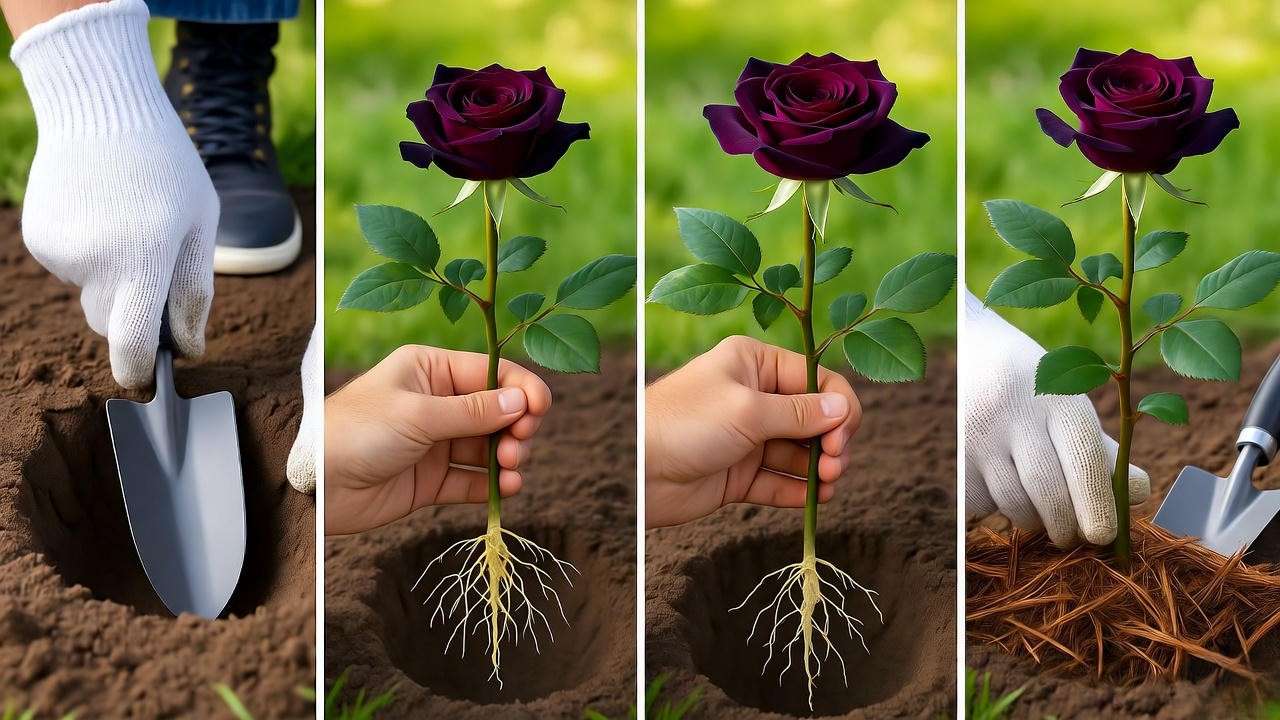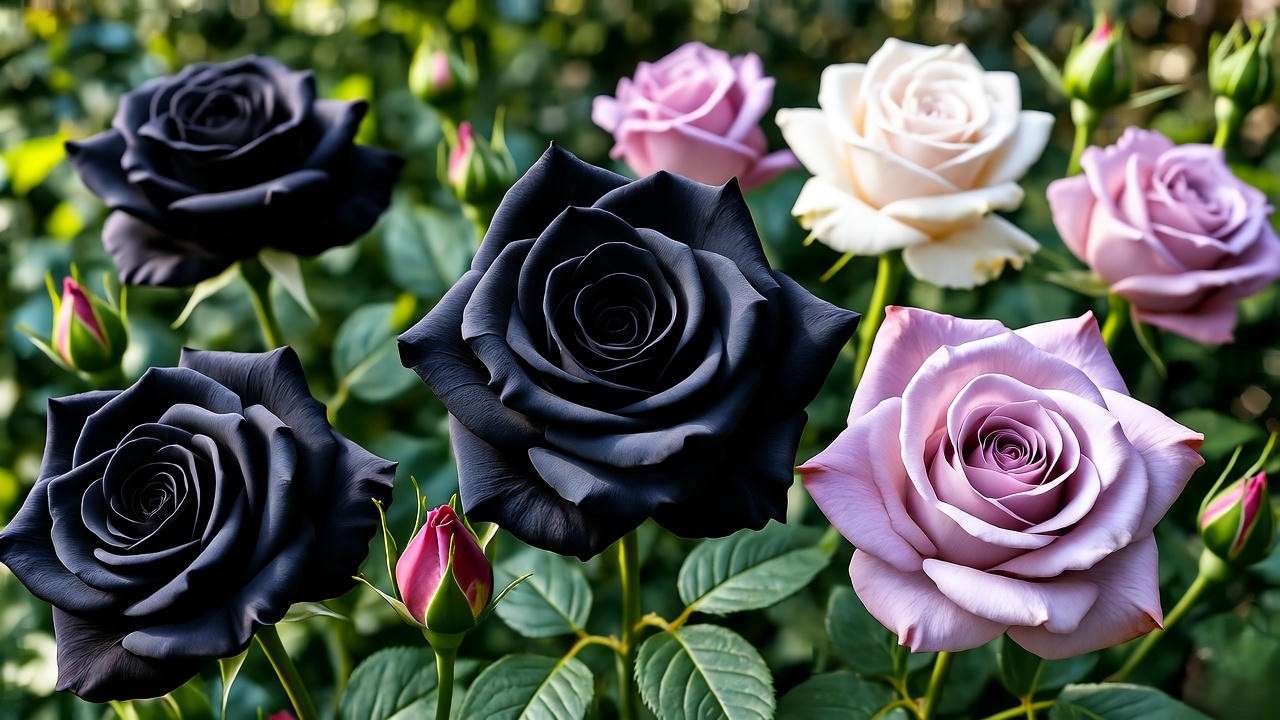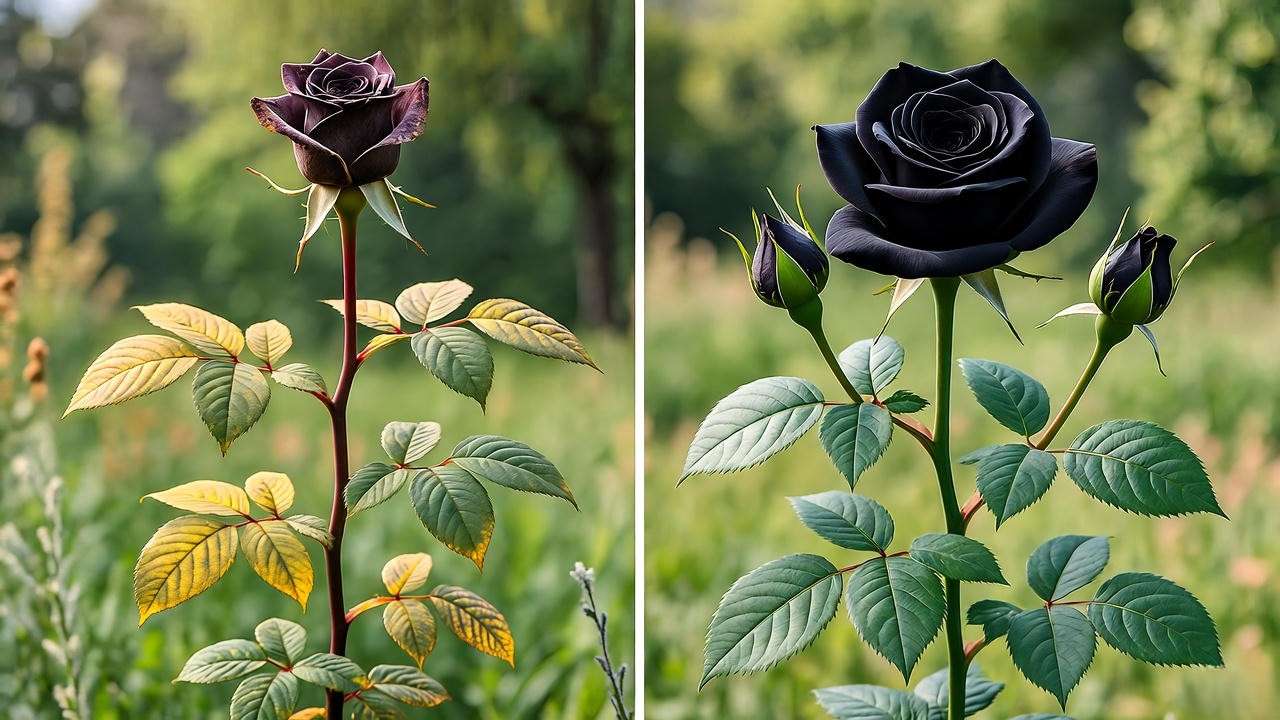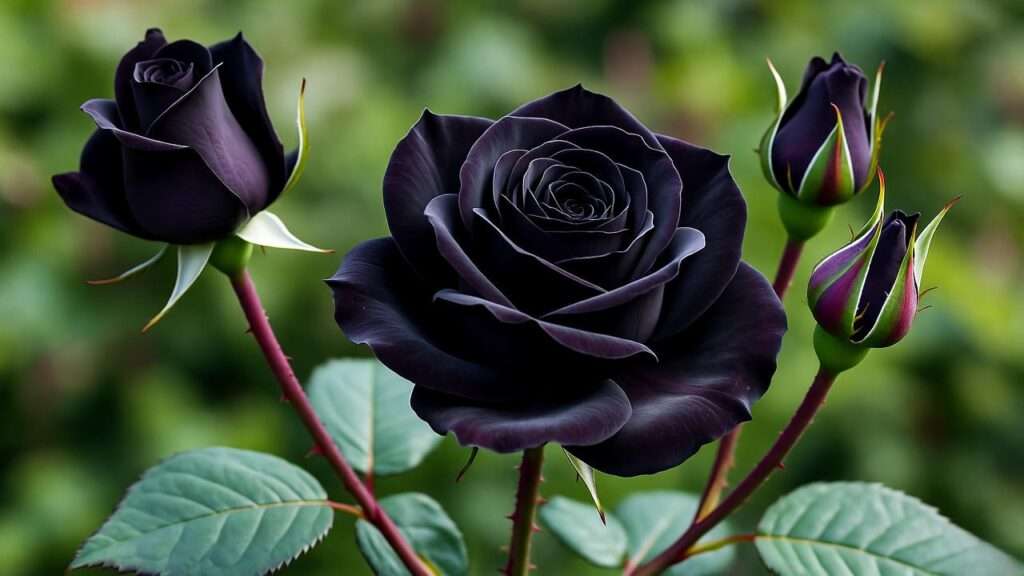Imagine a garden where velvety, near-black blooms steal the show, their mysterious allure turning heads and sparking conversations. The black rose plant, with its deep, enigmatic hues, is a gardener’s dream, blending elegance with a touch of rebellion. Whether you’re a novice or a seasoned horticulturist, growing a black rose plant can transform your garden into a masterpiece. In this comprehensive guide, we’ll unlock the secrets to cultivating these rare beauties, ensuring vibrant blooms and healthy plants. As a plant care expert with over a decade of experience cultivating rare roses, I’ve distilled years of knowledge into actionable tips to help you succeed. Let’s dive into the world of black roses and make your garden bloom with magic! ✨
1. Understanding the Black Rose Plant 🌑
1.1 What Is a Black Rose Plant?
Black roses aren’t truly black but boast deep red or purple shades that appear nearly black in certain lights. Varieties like Rosa ‘Black Baccara’ and ‘Black Magic’ are celebrated for their rich, velvety petals. These hybrid tea roses, developed through selective breeding, carry a unique charm, symbolizing mystery, elegance, and even transformation in cultures worldwide. From gothic weddings to literary symbolism, black roses hold a special place in horticulture and aesthetics. Their blooms, often 3–4 inches wide, exude a subtle fragrance, making them a favorite for ornamental gardens.
1.2 Are Black Roses Hard to Grow?
A common myth is that black roses are finicky or difficult to grow. In truth, their care requirements are similar to other hybrid tea roses, making them accessible to gardeners of all levels. With proper sunlight, soil, and maintenance, black roses thrive in most climates. Their hardiness and adaptability make them a rewarding choice, whether you’re planting in a garden bed or a container. The key is understanding their needs, which we’ll cover in detail below.
Expert Insight: “Black roses are less about complexity and more about consistency,” says Dr. Emily Thornton, a horticulturist with the American Rose Society. “With the right care, they’re as resilient as any rose.”
2. Choosing the Right Black Rose Variety 🌸
2.1 Top Black Rose Varieties for Your Garden
Selecting the perfect black rose variety sets the foundation for success. Here are three standout cultivars:
- Black Baccara: Known for its deep burgundy-black petals, this variety thrives in USDA zones 5–9. Its large, double blooms are ideal for cut flowers.
- Black Magic: A slightly lighter, reddish-black rose with excellent disease resistance. Perfect for warm climates and mixed borders.
- Midnight Supreme: A compact rose with a near-black hue, great for containers or small gardens.
Each variety has unique traits, so consider your climate, space, and aesthetic goals when choosing.
2.2 Where to Buy Quality Black Rose Plants
Purchase black rose plants from reputable nurseries like Jackson & Perkins or online retailers such as Edmunds’ Roses. Look for plants with strong, green canes and healthy root systems. Avoid suppliers offering suspiciously cheap plants, as they may be mislabeled or diseased. Check reviews and ensure the nursery specializes in roses for authenticity.
Pro Tip: Use this checklist when buying:
- Roots: Firm, white, and moist (for bare-root plants).
- Canes: At least 2–3 healthy stems, free of spots.
- Certification: Look for disease-free certifications from trusted suppliers.
3. Ideal Growing Conditions for Black Roses ☀️
3.1 Sunlight Requirements
Black roses need 6–8 hours of direct sunlight daily to produce vibrant blooms. In hotter climates, morning sun with afternoon shade prevents petal scorching. If you’re in a cooler region, maximize sun exposure to enhance color depth. Avoid planting near trees or structures that cast heavy shade.

3.2 Soil Preferences
These roses thrive in well-draining, loamy soil with a pH of 6.0–6.5. Test your soil with a home kit (available at garden centers) and amend with compost or aged manure to improve fertility. If your soil is clay-heavy, mix in sand or perlite for better drainage. Good soil prep ensures robust root development.
3.3 Climate and Hardiness
Black roses grow best in USDA zones 5–9. In colder zones, protect plants with mulch or burlap during winter. In hot climates, ensure consistent watering to prevent heat stress. Check your local hardiness zone at the USDA Plant Hardiness Zone Map for precise guidance.
Example: To prepare a rose bed:
- Dig a 2×2-foot area, 18 inches deep.
- Mix in 2–3 inches of compost and a handful of bone meal.
- Test pH and adjust with sulfur (to lower) or lime (to raise).
- Level the soil and water lightly before planting.
4. Planting Your Black Rose 🌿
4.1 When and Where to Plant
Spring or fall is ideal for planting black roses, allowing roots to establish before extreme weather. Choose a spot with ample sunlight and good air circulation to prevent fungal issues. For containers, select pots at least 18 inches wide and deep with drainage holes.
4.2 Step-by-Step Planting Guide
- Dig the Hole: Create a hole 18 inches wide and deep.
- Prepare the Plant: For bare-root roses, soak roots in water for 4–6 hours. For potted roses, gently loosen the root ball.
- Position the Rose: Place the graft union (the swollen part where the rose is grafted onto rootstock) just below soil level in cold climates or slightly above in warm climates.
- Backfill and Water: Fill with soil, tamp gently, and water thoroughly.
- Mulch: Add 2–3 inches of organic mulch (bark or wood chips) to retain moisture and deter weeds.
Visual Aid: A diagram showing proper planting depth can help visualize the graft union’s placement.

5. Essential Care Tips for Thriving Black Roses 🌺
5.1 Watering Needs
Water deeply once or twice weekly, delivering 1–2 inches of water to the root zone. Use a soaker hose or drip irrigation to keep foliage dry, reducing disease risk. Overwatering leads to root rot, while underwatering causes wilting. Check soil moisture with your finger—if the top inch is dry, it’s time to water.
5.2 Fertilizing for Vibrant Blooms
Feed black roses with a balanced fertilizer (10-10-10 NPK) in early spring, followed by a rose-specific fertilizer (e.g., 5-10-5) before blooming. Apply every 4–6 weeks during the growing season. Organic options like fish emulsion or compost tea work well, too. Avoid fertilizing after August to prevent new growth before winter.
5.3 Pruning for Health and Shape
Prune in late winter or early spring when buds begin to swell. Remove dead, damaged, or crossing canes, and cut back healthy stems to 12–18 inches, leaving 4–6 buds per cane. Use clean, sharp shears and disinfect between cuts with rubbing alcohol to prevent disease spread.
5.4 Pest and Disease Management
Common pests include aphids and spider mites. Control them with a strong water spray or neem oil (mix 1 tsp neem oil, ½ tsp dish soap, and 1 quart water). Black spot and powdery mildew are frequent diseases. Prevent them by ensuring good air circulation, avoiding overhead watering, and applying a sulfur-based fungicide if needed.
Expert Tip: Homemade neem oil spray recipe:
- Mix 1 tsp pure neem oil, ½ tsp mild liquid soap, and 1 quart water.
- Spray foliage in the evening to avoid sunburn.
- Reapply every 7–10 days as needed.
6. Enhancing Black Rose Aesthetics in Your Garden 🎨
6.1 Companion Planting
Black roses shine when paired with complementary plants that enhance their dramatic appeal. Consider these companions:
- Lavender: Its silvery foliage and purple blooms contrast beautifully with black roses, while its scent deters pests.
- Catmint: Low-growing with soft purple flowers, it creates a lush border and attracts pollinators.
- White Roses: Varieties like ‘Iceberg’ provide a striking contrast, amplifying the black rose’s depth.
Avoid planting near aggressive competitors like mint or trees with invasive roots, which can steal nutrients and water.

6.2 Design Ideas for Black Roses
Black roses are versatile for various garden styles:
- Gothic Garden: Pair with dark foliage plants like Heuchera ‘Obsidian’ or black mondo grass for a moody, elegant look.
- Modern Minimalist: Plant in sleek containers with white gravel for a clean, contemporary vibe.
- Romantic Border: Mix with pastel blooms like pink peonies or white lilies for a soft yet striking effect.
For containers, use black roses as focal points in large pots, surrounded by trailing plants like ivy. In mixed borders, place them at mid-height to draw the eye.
Inspiration: A gardener in Oregon transformed her backyard into a gothic paradise by lining a pathway with ‘Black Baccara’ roses, accented by deep purple salvia and silver lamb’s ear. Her design, shared on gardening forums, went viral for its haunting beauty.
7. Troubleshooting Common Black Rose Problems 🛠️
7.1 Why Aren’t My Black Roses Blooming?
Lack of blooms often stems from:
- Insufficient Light: Ensure 6–8 hours of direct sun. Relocate container plants or trim overhanging branches.
- Poor Nutrition: Test soil for deficiencies. Apply a phosphorus-rich fertilizer (e.g., 5-10-5) to boost flowering.
- Improper Pruning: Prune too late, and you may remove flower buds. Stick to late winter/early spring pruning.
Solution: Adjust light exposure, fertilize monthly during the growing season, and prune correctly to encourage blooms.
7.2 Yellowing Leaves or Wilting
Yellow leaves or wilting signal:
- Nutrient Deficiency: Iron or nitrogen shortages are common. Apply chelated iron or a balanced fertilizer.
- Overwatering: Check for soggy soil. Reduce watering frequency and improve drainage.
- Root Issues: Inspect for root rot (soft, brown roots). If present, trim affected roots and repot in fresh soil.
Solution: Diagnose with a soil test, adjust watering, and treat with appropriate nutrients or fungicides.

7.3 Dealing with Fading Color
Black roses may appear less vibrant due to:
- Sun Exposure: Too much direct sun can fade petals. Provide afternoon shade in hot climates.
- Soil pH: A pH above 6.5 can dull colors. Test and lower pH with sulfur if needed.
Solution: Maintain optimal pH (6.0–6.5) and adjust planting location for balanced light exposure.
Quick Reference Table:
| Symptom | Cause | Solution |
|---|---|---|
| No blooms | Low light, poor nutrition | Increase sun, fertilize with 5-10-5 |
| Yellow leaves | Nutrient deficiency, overwatering | Test soil, adjust watering |
| Fading color | High pH, excessive sun | Lower pH, provide shade |
8. Seasonal Care Calendar for Black Roses 📅
To keep your black roses thriving year-round, follow this seasonal guide:
- Spring (March–May): Prune to shape, fertilize with a balanced 10-10-10, and mulch to retain moisture. Monitor for aphids.
- Summer (June–August): Water deeply weekly, deadhead spent blooms to encourage reblooming, and apply rose-specific fertilizer monthly.
- Fall (September–November): Reduce fertilization, clean up fallen leaves to prevent disease, and plant new roses in mild climates.
- Winter (December–February): In zones 5–6, cover the base with 6–8 inches of mulch or burlap. In warmer zones, lightly prune to remove dead wood.
Regional Tip: In humid climates, increase air circulation by spacing plants 3–4 feet apart to prevent fungal issues. In arid regions, water twice weekly during summer heat.
Downloadable Resource: A printable seasonal care checklist can help you stay on track. Include tasks like “Check soil pH in spring” and “Mulch before winter.”

9. FAQs About Black Rose Plants ❓
Are black roses real?
Black roses are not naturally black but are deep red or purple hybrids bred for their dark hues. Their color comes from anthocyanin pigments, intensified through selective breeding.
Can I grow black roses indoors?
Indoor growing is challenging due to light requirements. Use grow lights (12–16 hours daily) and ensure excellent drainage in pots. Outdoor conditions are ideal for best results.
How long do black roses bloom?
With proper care, black roses bloom from late spring to early fall, with peak flowering in summer. Deadheading extends the bloom period.
Are black roses safe for pets?
Roses are generally non-toxic to cats and dogs, but thorns can cause injury. Keep pets away from plants to avoid scratches or ingestion of fertilizers.
What’s the best way to propagate black roses?
Propagate via cuttings in early summer:
- Take a 6-inch cutting from a healthy cane.
- Remove lower leaves and dip the cut end in rooting hormone.
- Plant in a mix of sand and peat, keeping moist until roots form (4–6 weeks).
10. Conclusion: Your Journey to Stunning Black Roses 🌟
Growing a black rose plant is a rewarding journey that blends art and science. By providing the right sunlight, soil, and care, you can cultivate these captivating blooms that elevate any garden. From choosing the perfect variety to troubleshooting issues, this guide equips you with expert knowledge to succeed. Start today—plant a black rose, nurture it with care, and watch your garden transform into a haven of elegance and mystery. 🌹
Explore more plant care tips on our website, or join our community of rose enthusiasts to share your black rose success stories! What’s your favorite black rose variety? Let us know in the comments!













